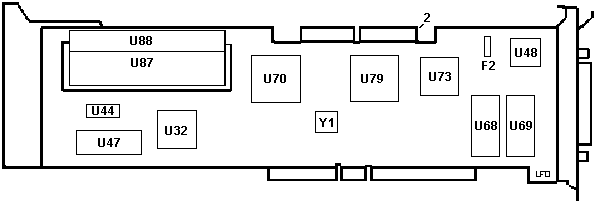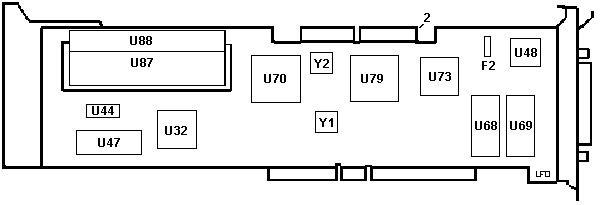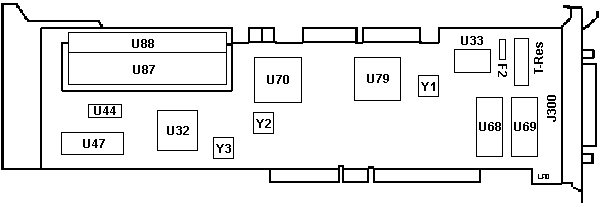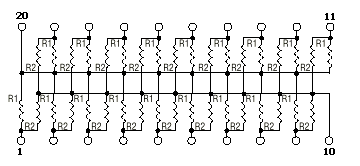|
C8EFF.ADF - Init file for _8EFF.ADF @8EFF.ADF - IBM PS/2 SCSI Adapter w/Cache (modified, no ADP, ROM area selectable / German comments) SCSIFIX.ZIP Finally! A utility to alter the number of sectors for a SCSI drive and convert them to a 3.94GB drive! Bob Eager, you have answered a prayer! U47 Firmware - 27C512 Original on ST M27C512 -12F1 Use any 27512 equivalent
SCSI BIOS 92F2244, 1991, for PS/2 Caching SCSI controller. 27C256 SCSI BIOS 92F2245, 1991, for PS/2 Caching SCSI controller 27C256 SCSI BIOS 64F4376 1990 (Old Spock) SCSI BIOS 64F4377 1990 (Old Spock) 33F5546 reports itself internally as 33F5547 OLD SCSI w/cache (Single oscillator)
OLD 6451018 (FCC-ID:ANO6451018) 
The C188 has 2x8-bit parallel-ports but only an 8-bit external data-path. The "old" IBM SCSI Adapter with cache /A has no internal termination resistor and needs the large external Terminator block. This adapter needs the update SCSI BIOS P/N 92F2244 / 92F2245 in order to handle drives >1GB. Note: The Adaptec AIC-6250EL Line interface chip is just "glue logic". NEWER 
FCC ID: ANO6451018 Mostly seen in Europe. This adapter needs the SCSI BIOS P/N 92F2244 / 92F2245 in order to handle drives >1GB. The "dual OSC"-adapter needs an external terminator. Ed. Odd, I have a single osc 6451018, BUT it has the solder pads and the outline for Y2.
NEWEST 
20MHz oscillator is for the SCSI-Line interface processor. 25MHz drives the cache controller. 32MHz clock for 80C186-16 microcontroller, which supplies the busmaster functions. The "latest" cached SCSI, FRU 85F0063 (FCC-ID ANOSPRIME), has no Adaptec chip present and a 20-pin DIL terminator chip close to the external port. This card has the strange 10-contact card edge connector close to the internal 50-pin card-edge. It has a third oscillator as well: a 32.0000MHz (Y3). New BIOS Improvements (From Tim Clarke) The upgrade provides the following additional capabilities:
Multiple, redundant partitions are useful if drive id. 6 fails. 'Recovery' can be automatic without partially ripping the machine down to change SCSI Id.s. You do, however, need to have planned for this and set up the appropriate 'IML/Reference Partition'(s) and 'Active Partition'(s) on the 'fallback' drives (Id. 5, 4, 3... etc.) Microcode Differences From Tony Ingenoso Making Your Own IBM Cable SCSI w/Cache The IBM SCSI adapter is 8-bit narrow, single-ended SCSI with SCSI-2 style command set and SCSI-1 speed of 5MB/s. It can handle 7 Fast- or Ultra-SCSI devices and can handle even 7 Wide-devices if there are converters used from Wide-to-narrow SCSI (68-to-50 pin) but these devices must use device numbers from 0 - 6. The SCSI-ID 7 is used for the controller itself. First device on IBM SCSI controllers is the one with the highest ID (6) opposed to Adaptec or Buslogic controllers which boot from ID (0) or (1). It can handle even Ultra-SCSI drives, because SCSI is compatible in any directions - other than shit-IDE. These SCSI adapters have a single bus that provides both internal and external SCSI bus connectors. For these adapters, devices are logically ordered depending only on adapter slot number and the SCSI IDs of the devices. NOTE: IBM SCSI adapters that use a SCSI BIOS earlier than the 92F2244 / 92F2245 pair will require the IML drive to be SCSI ID6. The SCSI w/Cache is a "Single Ended" SCSI controller, which means that every signal has GND as return line. The other relevant SCSI standard of "Differential" means, that every signal has a return line with inversed polarity ... when -for example- +DATA0 sends a logical "1" on the active line the return line -DATA0 sends a logical "0". The transceiver circuit in the device checks the *difference* between the two signals (therefore "differential") - line disturbances afflict both lines at once and are eliminated therefore. Autotermination Capable Adapters or Planars Peter, for the $64,000 Question. If you use a yellow termpack on a adapter or board that had a red one initially, will that enable it to autoterminate? Definitely: Not. The "Auto-Terminate" is a function that require a little more hardware: a switching transistor that disables the TermPwr wire from the T-RES and another transistor / IC function that senses the voltage on the TermPwr line and the voltage on the data lines to figure out whether the line is terminated or not. Terminator
Resistance Values It looks like this..
What about that Artifact? From Ian Brown How did I find out? I went to a 'Big Blue' re-union recently, and met one of the original designers of the IBM SCSI host adapters. I'd been wondering about that extra connector for years, so I took the opportunity to ask him. Pinouts for the SCSI /A and the SCSI w/Cache The edgecard for the SCSI Adapter /A has less contacts than the later SCSI w/Cache. Still wondering why... But you can see a tableized version (Thank you, thank you..) of Peter Wendt's observations. It is HERE. Swapping BIOS chips for >1GB Support From Peter Wendt Today - while juggeling around with parts & cards on a Model 90 - I decided by what reason to remove the SCSI-Bios from an old uncached SCSI and stuff that from the "later" cached on it. Earlier this year I'd tried to swap the entire Eprom-Sets among the old and the later cached - and it did not work. Today I left the busmaster microcode Eprom on the card and only swapped the SCSI-Bios. To my undescribeable surprise: it worked. To make sure that it is not a gimmick of that machines' Bios I tried it on a Mod. 70-A21, which has definitely no enhanced SCSI-Bios support in the planar microcode. I pulled the 2GB IBM 0664 harddisk from my WinNT Server and installed it in the Mod. 70. I have a heavily modified Mod. 70 - has a standard power-plug (as described on my page, folks !) and a Kingston 486DX-33 upgrade. I also installed the uncached SCSI with the old Eproms. No surprise: "No operating system" and the system halted. Then I used the 92F2244 and 92F2245 on that same adapter ... Voilà: "OS Loader V4.00 ..." and WinNT 4.0 Server started up ... ! (Ever seen that on a Mod. 70 ?) Tried the same procedure with the old IBM SCSI adapter with cache (the one *with* the AIC-6250EL Line Interface) - with the same results. Old Bios-chips: No operating system - New chips: Win NT starts Conclusion: If you have one of the older SCSI-Adapter *cards* you can use the SCSI-Bios from the later-level SCSI Adapter with cache to make the system capable to handle drives over 1GB. I do *not* know if there is another limit after 4GB - but assume it is (I don't have drives over 2.2GB currently). This limitation will at least exist on the IML-machines, since the principle that starts up the IML cannot handle drives over 3.94GB (the mysterious IML-border) due to the technical method of putting the systempartition MBR at *the end* of the physical diskspace. The register width is obviously limited to any number of total data-blocks below 4GB. So that does not change at all. Complex BIOS
Upgrade Needed for >1GB IML Drive From another thread Some Other Thoughts If replacing the earlier version adapter with the new version, the 2MB SCSI w/cache Increasing the cache to 2MB
It has 9 OKI M511000A-1AJ chips, mnf. 89335521 Kingston modules labeled KTM-1000/M30 (From Peter) From Jerry Dumer
Trying Non-Compatible SIMMs If you try some likely looking 30 pin SIMMs and they don't have the correct CAS/RAS wiring, the system will disable them it and you will see SCSI Adapter w/Cache with 0KB. Don't freak out. Replace the original SIMMs and run Advanced Diags and test the SCSI Adapter to restore your 512K cache. Been there, done that. Converting Industry Standard Memory Yes. Alfred Arnold has finally figured it out. Dr. Jim Shorney confirms this triumph. The biggest hurdle was the IBM modules have a different RAS/CAS scheme in addition to the different pin-out. As time goes on, exceptions MAY be found. News as it happens Alfred's
30-pin SIMM Hack (To his site) 1. Break connection between SIMM pin 26 and parity chip's DataOut pin; This inferrs that SIMM pin 26 goes to Data Out- 2. Connect parity chip's DataOut pin to SIMM pin 29; 3. Tie parity chip's lead that USED to go to SIMM pin 26 to SIMM pin 29 4. Break connection between SIMM pin 28 and the parity chip's CAS
pin; 5. Parity chip CAS is attatched to SIMM pin 28 6. Connect parity chip's CAS pin to SIMM pin 2; 7. Attatch lead that used to go to SIMM pin 28 to SIMM pin pin 2 8. Connect both SIMM pins 26 and 24 to SIMM pin 22 (GND). 9. Tie SIMM 26 and 24 off to SIMM 22 A picture of Dr. Jim's 2MB Hack
8MB Hack? Peter says: No. It is a little miracle that the 1MB modules work for the 2MB total cache, but the 4 Meggers are -again- different to the 1MB ... apart from the presence detection and the RAS/CAS scheme. There are 1MB modules that behave the same way than the 256K modules - but no 4MBs. The 4MB you find are either Industrial Parity (9 bit, but w.o. presence detect) or non-Parity Industrial modules (8-bit). IBM itself never introduced 4MB modules of that scheme for their own machines. The PS/VP Series 1 used 1 and 4MB 30-pin modules, but these were "industrial standard" modules. The PS/2 256K, 512K and 1MB modules are very unique. They depend -technically- on a very old (1985) Hitachi patent to which IBM only added the presence detection. From the principle the "Single RAS" scheme of these modules is similar to the Hitachi HB61009BR-15, 150ns module - a very antique construct, which were superseeded by the much more common HB41256-style design, which uses separate RAS/CAS timing for interlaced access to the cell-array, which then allowes much faster RAM access (typically 100 - 60ns). Testing SIMMs for use in SCSI Adapter w/cache The secret is out... Results of upgrading
This depends on more factors than just the interface-speed:
Okay - for the curiousity: I have tested the 2MB-cache in my 8595-AK9 (32MB RAM / Kingston TurboChip / modified BIOS) with 2 different IBM adapters and a Quantum Fireball TM2110S (2.1GB Ultra-SCSI). This drive is known as quite fast and should not be the bottle-neck. I used the IBM SCSI adapter with cache /A in the version *without* the internal termination resistor and the Adaptec AIC Line interface chip (IBM old) and I used the IBM SCSI Adapter with cache /A *with* the internal yellow termination resistor and the IBM SCSI Interface (IBM new). Here are some test-samples (results are temporary examples)
Results of reading and writing blocks from 512 bytes to 63.5KB in
linear and random methods. What does this mean in practise ?
The testing will continue as soon as possible. Like very often
my job came in the way and I needed the 95 (which is usually my network-server)
for the daily purposes again. But this first testing suite shows that
the enlarged cache *has* in fact a good impact on the over-all performance
of the system. I'll try to fix up the results and try bringing them here
- if you like "data cemetries"... the tables are *very* complex and have
hundreds of numbers, which must be set in proper relation to each others.
And must be interpreted the correct way. AdapterID 8EFF "IBM PS/2 SCSI Adapter w/Cache" I/O Address DMA Arbitration Level Fairness On/Off ROM Wait State Disable SCSI Adapter Address (ID) ADPItem 1 ROM Address Range
|

